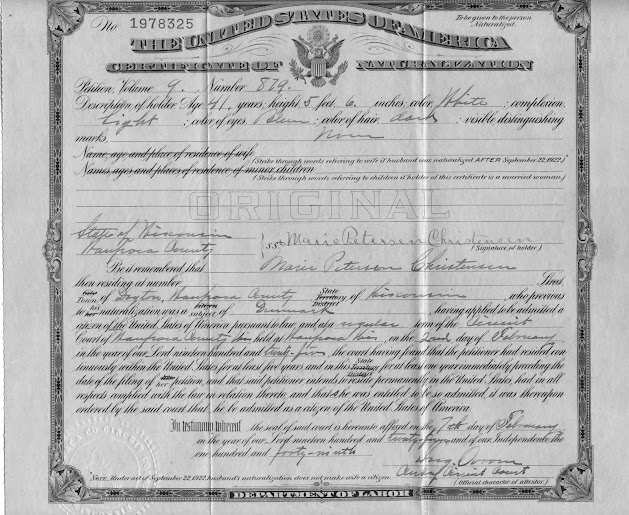 |
|
Marie (Petersen) and Christian A (C.A.) Christensen about the time of their marriage in 1904. |
The United States is a "Nation of Immigrants," in a phrase popularized by a 1958 book written by then-Senator John F. Kennedy. From colonial times until now, waves of people have come to this land seeking to make a better life for themselves and their families. It must be acknowledged that these waves dispossessed the Native peoples who had lived in North America for thousands of years, and that hundreds of thousands of others were brought here against their wills to be enslaved.
Many Americans celebrate their immigrant ancestries and honor the contributions their forebears have made to building the country in which we live. The ugly side of the story is that each wave of immigrants were met with prejudice, stereotypes, and discriminatory laws and social treatment.
According to the editors of History.com
"Between 1880 and 1920, a time of rapid industrialization and urbanization, America received more than 20 million immigrants....The peak year for admission of new immigrants was 1907, when approximately 1.3 million people entered the country legally."
My great-grandparents, Marie (Petersen) Christensen, and her husband, Christian Andrew (C.A.) Christensen were part of this wave and found themselves caught up in the backlash.
Marie was born in Racine, Wisconsin, on 27 February 1883, to Danish immigrants Robert and Karen Petersen. Marie was granted citizenship by birthright, a privilege extended by the 14th Amendment to all people born in the United States or its territories. C.A. Christensen was born in Denmark in 1881 and came as a child in 1888 to Wisconsin with his parents, Jens and Caroline. He would remain a Danish citizen until such time as he would complete the Naturalization process.
It is unlikely that Marie and C.A. gave much thought to the citizenship implications of their marriage in January 1904. I believe they were more focused on where they would live and how they would support the family they hoped to build together.
Although it may seem surprising today, there was a time in the United States when the citizenship of a married woman was tied to the citizenship of her husband. This principle was embodied in federal law when the U.S. Congress passed the Expatriation Act of 1907, which stated that "any American woman who marries a foreigner shall take the nationality of her husband."
According to Meg Hacker, of the U.S. National Archives:
If an American woman married a foreigner before 1907 and the married couple continued to reside in the United States, she did not, because of her marriage, cease to be an American citizen. The American woman remained a U.S. citizen even after her marriage to a non-U.S. citizen.
Even though Marie and C.A. were married in 1904, they apparently believed that she had lost her citizenship by marrying a Danish citizen. They must have been relieved when Congress passed the Cable Act of 1922 (approved 22 September 1922, it was also known as the Married Women's Citizenship Act or the Women's Citizenship Act). Both Marie and C.A. petitioned to become naturalized American citizens – in Marie's case, she petitioned to have her birthright citizenship restored – in August 1924.
The section of Marie's petition form where she was to declare her intention to become a citizen of the United States was crossed out...
and covered by the following typescript statement:
Marie's United States Citizenship was restored on 27 February 1925. Here is her Certificate of Naturalization:
C.A. was granted citizenship in February 1925 at the same time as Marie, but that's another story...
Sources:
"Cable Act of 1922", Immigration History, a project of the Immigration and Ethnic History Society (2019); web page (https://immigrationhistory.org/item/cable-act/ : Accessed 30 May 2022).
Hacker, Meg, "When Saying "I Do" Meant Giving Up Your U.S. Citizenship", Prologue (Spring 2014), U.S. National Archives and Records Administration, College Park, Maryland; digital article (https://www.archives.gov/files/publications/prologue/2014/spring/citizenship.pdf : Accessed 29 May 2022).
History.com editors, "U.S. Immigration Before 1965", History, A&E Television Networks (10 September 2021);digital article (https://www.history.com/topics/immigration/u-s-immigration-before-1965 : Accessed 29 May 2022).
"Expatriation Act of 1907", Immigration History, a project of the Immigration and Ethnic History Society (2019); web page (https://immigrationhistory.org/item/an-act-in-reference-to-the-expatriation-of-citizens-and-their-protection-abroad/ : Accessed 30 May 2022).
“Naturalization Records, 1853-1943”, Waupaca County, Wisconsin, Clerk of Courts. Petitions, 1921-1925, Waupaca Series 16, Volume 9, Petition No. 879, Filed 2 August 1924, Marie Petersen Christensen; digital images, FamilySearch.org, “Wisconsin County Naturalization Records, 1807-1992”, (https://www.familysearch.org/ark:/61903/1:1:ZXSV-NXN2 : 30 May 2022) image nos. 246-250. (Viewing the image of Marie's petition requires a free-of-charge FamilySearch.org account)
“Naturalization Records, 1853-1943”, Waupaca County, Wisconsin, Clerk of Courts. Petitions, 1921-1925, Waupaca Series 16, Volume 9, Petition No. 866, Filed 1 March 1924, Christian Andrew Christensen; digital images, FamilySearch.org, “Wisconsin County Naturalization Records, 1807-1992”, (https://www.familysearch.org/ark:/61903/1:1:ZZMK-5Q2M : accessed 30 May 2022), image nos. 206-209. (Viewing the image of C.A.'s petition requires a free-of-charge FamilySearch.org account)
Wikipedia contributors, "Cable Act," Wikipedia, The Free Encyclopedia, https://en.wikipedia.org/w/index.php?title=Cable_Act&oldid=1084647817 (Accessed May 30, 2022).



.JPG)

